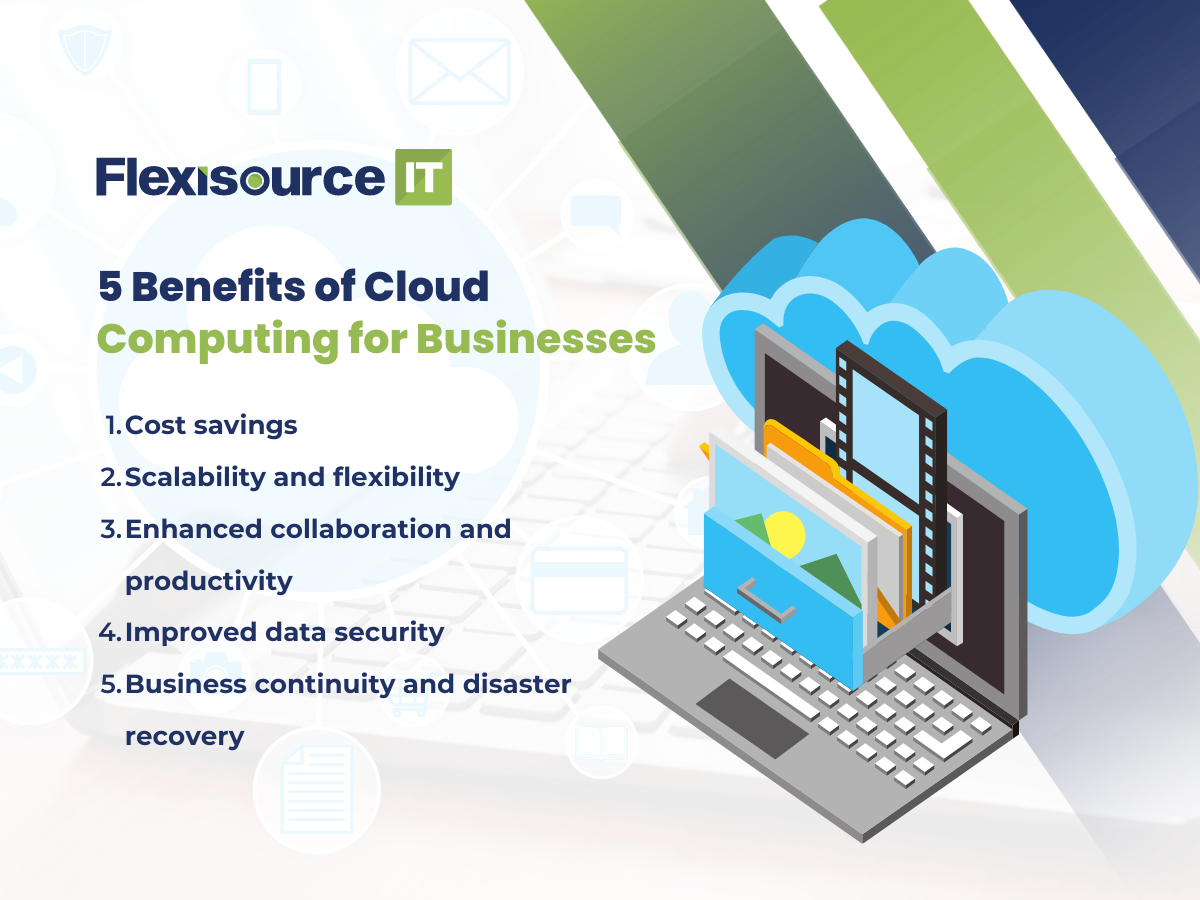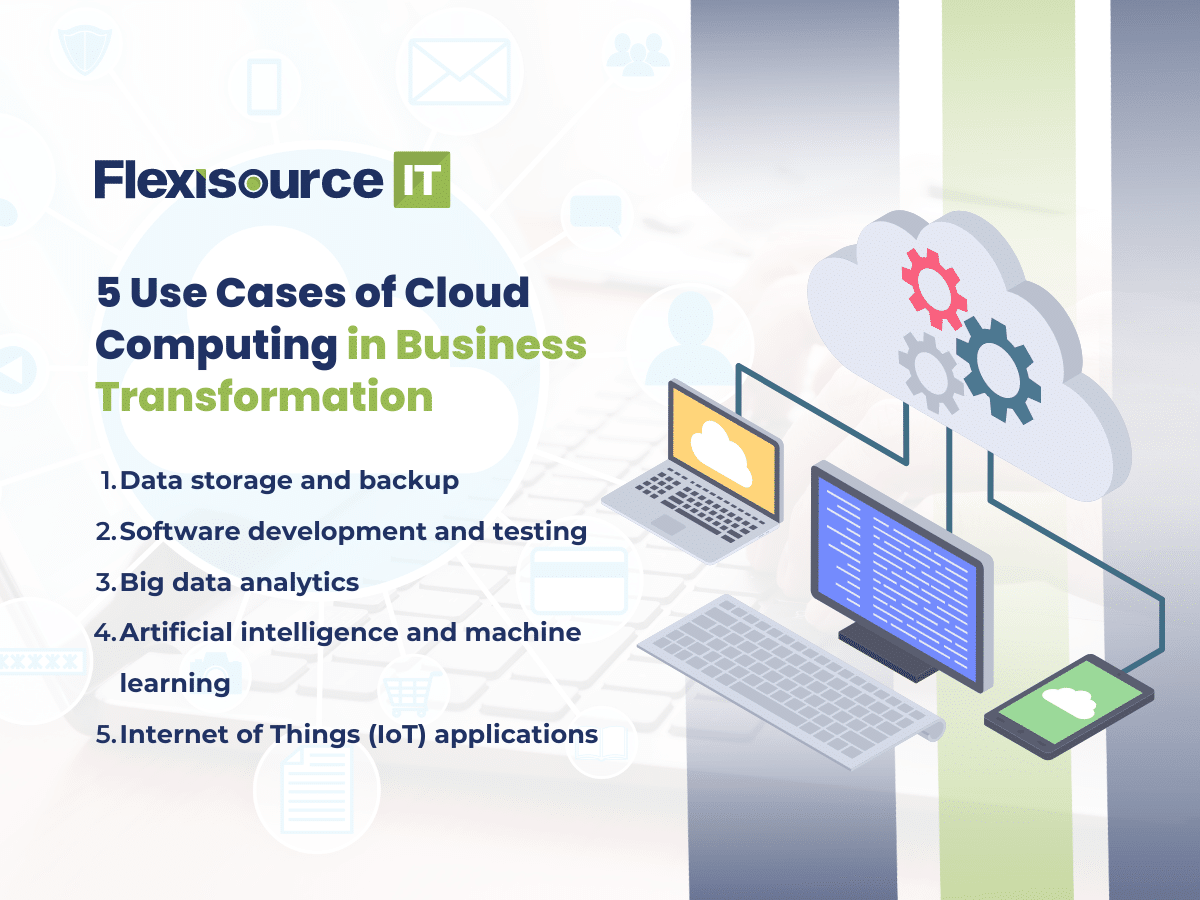In today’s fast-paced and ever-evolving digital landscape, cloud computing has emerged as a revolutionary force, reshaping how companies use technology and operate. It empowers businesses to meet the challenges of a dynamic market, transform customer service, and automate various repetitive tasks.
Likewise, multinational corporations and start-ups now use cloud-based services to streamline operations, boost efficiency, and drive innovation. However, embracing cloud computing goes beyond mere data storage; it represents a fundamental shift in how organizations approach their IT infrastructure and resource management.
So, in this article, we will unravel the core characteristics of cloud computing. We will also highlight its transformative effect on business processes, collaborative workflows, and customer experiences.
What is cloud computing?
Before learning how it transforms businesses, first, we must know the definition of cloud computing. Basically, cloud computing is a technology that allows users to access and utilise various computing resources, such as servers, storage, databases, software applications, and more, over the internet.
The term “cloud” is used as a metaphor for the internet. When you store or process data in the cloud, you use the resources provided by a network of remote servers distributed across different geographical locations.
Instead of relying on local servers or personal computers to handle data and perform tasks, cloud computing enables individuals and organizations to leverage the power of remote servers hosted by third-party providers.
These servers are managed and maintained by cloud service providers like Amazon Web Services (AWS), Microsoft Azure, Google Cloud Platform (GCP), and others.
5 Benefits of Cloud Computing in Business
As mentioned earlier, cloud computing provides benefits to a business. It is flexible, reliable, efficient and can help lower technology costs. Similarly, it allows organisations to automate tasks, incorporate AI and machine learning, and achieve faster time to market.
With that said, here are some benefits that can ultimately provide more profit to a company and enhance its productivity. As such, here are some advantages of cloud computing in business.

A. Cost savings
One of the key reasons why cloud computing in business is cost-effective is its pay-as-you-go model. Companies only pay for the resources they use, allowing them to scale up or down as needed without wasting money on unused capacity. This flexibility reduces operational costs and ensures businesses can quickly adapt to changing demands and market conditions.
Additionally, cloud computing eliminates the need for on-site data centres and IT staff, reducing maintenance, upgrades, and security costs. Cloud service providers handle these tasks, allowing businesses to focus on their core competencies instead of managing complex IT infrastructures.
Furthermore, cloud computing offers economies of scale by pooling resources across multiple users. Service providers can leverage their large-scale infrastructure investments to provide services at a lower cost per user than individual companies setting up their infrastructure.
B. Scalability and flexibility
Its scalability and flexibility are another important ground for incorporating cloud computing in business. Cloud computing offers the ability to scale computing resources up or down based on demand.
With traditional on-premises infrastructure, you typically need to invest in and maintain hardware and software to handle peak loads. In contrast, cloud service providers offer a scalable infrastructure where you can quickly increase or decrease the resources based on your needs.
This flexibility allows you to handle sudden spikes in traffic or scale resources as your business grows without worrying about upfront costs or infrastructure limitations.
C. Enhanced collaboration and productivity
One of the key benefits of cloud computing in business is its ability to provide real-time access to files and data from anywhere, at any time. This means team members can collaborate on projects and documents simultaneously, regardless of their physical location.
Furthermore, cloud computing offers seamless file-sharing capabilities. Team members can easily upload, store, and share files, ensuring everyone can access the necessary information. This promotes efficient collaboration by eliminating delays caused by searching for specific files or waiting for them to be sent via traditional methods.
Another advantage of cloud computing is its ability to facilitate communication among team members. Cloud-based collaboration tools often include instant messaging, video conferencing, and virtual meeting rooms. These tools enable teams to communicate effectively regardless of physical proximity, fostering better collaboration and idea-sharing.
Moreover, cloud computing enhances project management by providing centralised platforms where teams can track progress, assign tasks, set deadlines, and monitor project milestones. This ensures everyone is on the same page regarding project status and responsibilities.
D. Improved data security
One key aspect of how cloud computing in business improves data security is through enhanced infrastructure and robust security protocols. Cloud service providers invest heavily in state-of-the-art infrastructure, including advanced firewalls, intrusion detection systems, and encryption mechanisms. This ensures that sensitive data stored in the cloud remains secure from unauthorised access or breaches.
Another crucial aspect of cloud computing’s impact on data security is its ability to facilitate centralised management and control over access permissions. With cloud-based solutions, administrators can easily define user roles and permissions, ensuring that only authorised individuals can access sensitive information. Furthermore, real-time monitoring tools enable proactive threat detection and response by identifying suspicious activities or anomalies within the system.
Lastly, cloud computing offers regular software updates and patches to address emerging security vulnerabilities promptly. Cloud service providers continuously monitor for potential threats and promptly deploy necessary updates to secure their systems against evolving cyber threats.
E. Business continuity and disaster recovery
Additionally, cloud computing offers improved disaster recovery capabilities. Traditional on-premises data storage solutions often rely on physical backup methods susceptible to damage or loss. In contrast, cloud-based backups provide automated and redundant storage options across multiple locations. This means organizations can quickly recover their data without compromising its integrity, even in a disaster or hardware failure.
5 Challenges and Consideration for Adopting Cloud Computing in Business
While cloud computing in business has significant benefits, it may also face some issues. Navigating the path to successful cloud adoption has challenges and considerations. Here are some of them.

A. Data privacy and compliance
One of the significant concerns related to cloud computing in business is the issue of data privacy. When data is stored in the cloud, companies rely on the cloud service provider for its security and protection. This means they have limited control over how the data is handled, stored, and secured. The lack of control can create uncertainties regarding the privacy and security of the data.
While cloud service providers invest heavily in security measures, there is always a risk of insider threats. These threats can come from employees or contractors with authorised access to the cloud infrastructure and may intentionally or unintentionally compromise data privacy. A data breach at the provider’s end could result in unauthorised access to sensitive information. This breach can lead to data leaks, identity theft, or other malicious activities.
B. Vendor lock-in
Vendor lock-in is a potential issue associated with cloud computing in business, referring to the dependency of a business on a particular cloud service provider and the challenges involved in migrating to an alternative provider.
Long-term contracts or service agreements with a cloud provider may contain terms and conditions that complicate switching providers or migrating data. These contractual obligations can restrict the flexibility and freedom of businesses to explore alternative options.
Cloud service providers often offer unique features, tools, or services specific to their platforms. Businesses may become reliant on these features, making switching to a different provider that lacks similar capabilities or services difficult.
C. Network connectivity and latency
Network connectivity and latency can present several issues in cloud computing environments. Cloud computing heavily relies on network connectivity to access and transfer data between the client’s infrastructure and the cloud service provider. Any disruptions, such as network outages or intermittent connectivity issues, can impact the availability and performance of cloud services.
Likewise, when accessing cloud services over the network, high latency can result in delays in data transfer, slow application response times, and degraded user experience. This can be particularly problematic for real-time applications or services that require low latency, such as video streaming or online gaming.
D. Service level agreements (SLAs)
Service Level Agreements (SLAs) in cloud computing define the agreed-upon service levels between the cloud service provider and the client. While SLAs aim to ensure performance and availability guarantees, several issues can be associated with them.
Some SLAs may contain complex technical jargon or ambiguous language, making it difficult for clients to understand the service commitments and performance metrics fully. Lack of clarity can lead to misinterpretation and disputes regarding the agreed-upon terms.
E. Cloud migration strategies
Cloud computing in business is a complex process that involves moving applications, data, and other IT resources from on-premises infrastructure to cloud-based services. As such, it requires a precise strategy and approach to execute flawlessly.
First, moving large volumes of data to the cloud can take time, mainly if the organization’s internet connection has limited bandwidth. Adequate planning for data transfer speed and bandwidth availability is essential to minimise migration downtime. Likewise, some legacy applications may need to be compatible with the cloud environment. In addition, different industries have specific compliance regulations for data handling and storage.
Addressing these cloud migration strategy issues with a well-planned and phased approach can help organizations minimise risks, maximise benefits, and ensure a successful migration to the cloud.
5 Use Cases of Cloud Computing in Business Transformation
As mentioned earlier, cloud computing has become an indispensable part of modern businesses, revolutionizing how companies operate and transform their processes. With its scalable infrastructure and flexible capabilities, cloud computing offers numerous use cases that drive business transformation.
Here are five critical use cases where cloud computing is making a significant impact:

A. Data storage and backup
One of the primary use cases of cloud computing in data storage is its ability to provide virtually unlimited storage capacity. Instead of relying on physical servers or hard drives, businesses can now store their data securely in the cloud. This eliminates the need for expensive hardware investments and allows for easy scalability as storage needs grow. Likewise, it offers solutions that enable convenient access to data from anywhere at any time, facilitating seamless collaboration among teams working on large-scale data analysis projects.
B. Software development and testing
Cloud computing has revolutionised software development and testing, offering numerous advantages to developers and testers. In software development, cloud computing allows developers to access vast resources such as virtual machines, databases, development platforms, and APIs on demand. This eliminates the need to establish and maintain complex infrastructure locally, saving valuable time and resources.
Cloud computing facilitates CI/CD pipelines, automating the process of building, testing, and deploying software updates. Developers can integrate code changes into the main repository, triggering automated testing and deployment workflows, accelerating software delivery, and reducing manual interventions.
Likewise, it provides a scalable infrastructure for testing that accommodates various testing requirements. Testing environments can be easily provisioned or scaled up or down based on demand, allowing organizations to efficiently manage their testing cycles without investing in additional hardware or infrastructure.
C. Big data analytics
Cloud computing has revolutionised the way big data analysis is conducted. One of the primary applications of cloud computing in big data analysis is storage. The ability to store vast amounts of data in remote servers allows businesses to overcome the limitations of physical storage devices.
Additionally, cloud computing offers powerful processing capabilities that empower organizations to process and analyse massive datasets with unparalleled efficiency. Cloud-based big data platforms, like Amazon EMR, Google Cloud Dataproc, and Azure HDInsight, enable the parallel processing of large datasets using distributed computing frameworks like Apache Hadoop and Apache Spark. These platforms facilitate data extraction, transformation, and loading (ETL) processes, preparing the data for analysis.
Likewise, cloud-based big data platforms also provide essential tools and services specifically designed for advanced analytics tasks. These include machine learning algorithms, predictive modelling tools, and visualization frameworks that enable businesses to gain deep insights from their datasets.
D. Artificial intelligence and machine learning
Cloud computing plays a significant role in enabling the advancement and widespread adoption of artificial intelligence (AI) and machine learning (ML) technologies. One key aspect is storing and accessing large datasets through cloud storage solutions on remote servers. This allows AI and ML algorithms to leverage massive amounts of data for training models and making accurate predictions.
Moreover, cloud platforms provide robust computational power vital for running resource-intensive AI and ML workloads. With access to virtual machines or container instances through cloud services, developers can leverage high-performance computing capabilities without investing in expensive hardware infrastructure.
Additionally, cloud service providers offer pre-built AI/ML frameworks, libraries, and tools that simplify development processes across various domains. These ready-to-use resources save time by providing developers with sophisticated algorithms to build upon.
E. Internet of Things (IoT) applications
Cloud computing plays a crucial role in enabling the full potential of IoT. First and foremost, it provides a scalable infrastructure capable of handling the tremendous amount of data generated by IoT devices.
Additionally, cloud computing in business enables seamless integration and interoperability between different IoT devices. It also enhances security measures within the IoT ecosystem and provides flexibility to both customers and organizations.
Start using cloud computing with Flexisource IT!
Cloud computing has become an essential tool in today’s digital landscape, offering businesses unparalleled flexibility, scalability, and cost-effectivenessa. With Flexisource IT as your trusted partner, you can seamlessly transition your operations to the cloud and unlock a multitude of benefits.
We can empower your organization with enhanced storage capabilities, streamlined processes, and improved collaboration. Whether you are a small start-up or an established enterprise, our tailor-made solutions will meet your unique requirements and propel your business forward. Contact us now!









